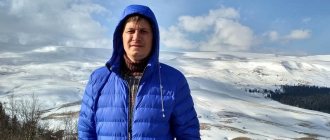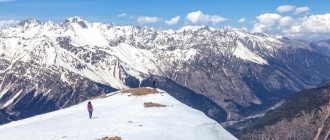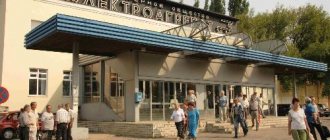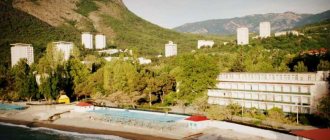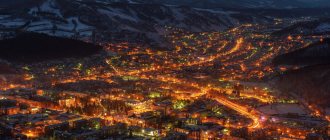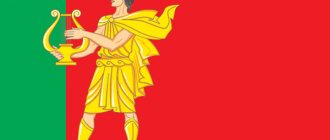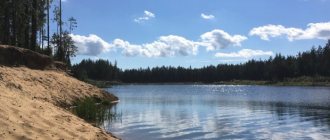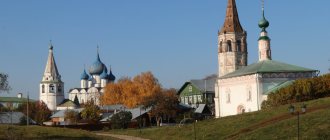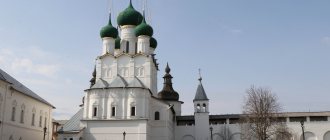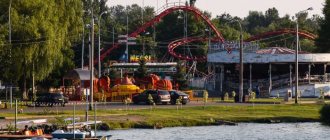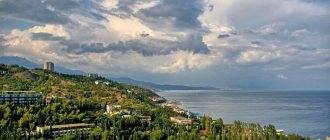The Altai Republic (in Altai, Altai Republic) is a subject of the Russian Federation, part of the Siberian Federal District. The Altai Republic is usually called the Altai Mountains. The administrative center of the region is the city of Gorno-Altaisk. The distance from Gorno-Altaisk to Biysk is about 98 km, to Barnaul – 260 km, to Novosibirsk – 450 km. The administrative-territorial division of the Altai Republic includes one city and 10 districts.
Altai Republic on the map.
Geographical Altai is located in the south of Western Siberia, in the very center of Eurasia. On its territory, which is part of the Russian Federation, there are two administrative regions: the Altai Republic and the Altai Territory. The climate here is sharply continental. The Altai Republic is located in the time zone MSK+4 (UTC+7), covering an area of 92,903 sq. km. and borders:
- In the West, North-West, North - with the Altai Territory.
- In the Northeast - Kemerovo region.
- In the East – the Republic of Tyva, the Republic of Khakassia and.
- In the South - Mongolia (Bayan-Ulgii aimag) and China (Xinjiang Uyghur Autonomous Region).
- In the South-West - Kazakhstan (East Kazakhstan region).
What holiday is it today?
February 10, 2022, Thursday
Today are holidays, events: Diplomat's Day Tomorrow: World Sick Day Discovery of insulin
Today is the Orthodox holiday: St. Ephraim the Syrian. Venerable Ephraim of Novotorzhsky. Venerable Ephraim of Pechersk, Bishop of Pereyaslavl. Venerable Theodosius of Totem, Spasosumorin of the monastery, leader and founder... Tomorrow: Transfer of the relics of the holy martyr Ignatius the God-Bearer. Saints Gerasim, Pitirim, Jonah, bishops of Great Perm, Ustva...
Today is a national holiday: Ephraim's Day... Tomorrow: Lawrence's Day
Seasons
Seasons, four periods of the year (spring, summer, autumn and winter) characterized by certain average temperatures. The period during which the Sun passes through one of these sectors is called the season. Spring in the Northern Hemisphere and autumn in the Southern Hemisphere begin when the Sun passes through the initial circle of declination and its right ascension is 0° (vernal equinox). Summer in the Northern Hemisphere and winter in the Southern Hemisphere occur when the sun's right ascension is 90° (summer solstice). Autumn in the Northern Hemisphere and spring in the Southern Hemisphere begin when the sun's right ascension is 180° (autumnal equinox). The beginning of winter in the Northern Hemisphere and summer in the Southern Hemisphere is considered to be the winter solstice, when the direct ascension of the Sun is 270°... Next: Seasons. Russian folk calendar. Monthly words...
Industry
The share of industry in the sectoral structure of the gross regional product of the Altai Republic in 2003 was 4.9%, agriculture - 21.3, construction - 10.5, transport - 1.5, communications - 1.6, trade and commercial activities for the sale goods and services - 9.0%. The economically active population in 2004 was 95 thousand people (46.6% of the total), 83.6 thousand (88%) are employed in the economy. The level of officially registered unemployment is 9.6%. The leading sector of the economy of the Altai Republic remains agriculture, specializing mainly in the production of livestock products (79.2% of total agricultural production). Wool and meat sheep breeding and beef cattle breeding are of predominant importance in livestock farming. Horse breeding, breeding of downy goats and industrial maral breeding are also developed in the region. Mountain Altai is the largest region in Siberia in terms of the number of downy goats and the largest in the country in terms of the number of deer and sika deer (until recently - 3/5 of the population of deer and deer). In the southern regions of the republic, camels and yaks are bred. Beekeeping has been practiced in the mountains for a long time. In 2004, the number of cattle was 139.9 thousand, sheep and goats - 493.5 thousand. 18.1 thousand tons of meat, 67 thousand tons of milk, 710 tons of wool were produced. The sown area is 101.2 thousand hectares (cereals - 51.9%, fodder - 38, potatoes and vegetables and melons - 9.9, industrial crops - 0.2%). The leading producers of grain are large and medium-sized agricultural enterprises (96.1%), meat and milk - personal household plots of the population (76.7 and 80.9%, respectively). The share of farms in meat production is 9.1%, milk - 7.2, grain - 3.9%.
Structure of industrial production: electric power industry - 27.9%, food industry - 20.5, non-ferrous metallurgy - 16.8, flour-grinding and feed milling - 13.5, light industry - 9.2, mechanical engineering and metalworking - 8.6, fuel — 7.3, forest. and woodworking - 1.1%. The food industry processes local agricultural raw materials and produces products for many parts of the country, primarily butter and cheeses. Gold mining is carried out in the Altai Republic. The main mode of transport is road, which accounts for 90% of traffic. The main highway is the Chuisky tract (more than 600 km), running from Biysk to the border with Mongolia. The total length of paved roads is 2.7 thousand km. Airports in Gorno-Altaisk, Ust-Koks and Kosh-Agach.
Folk calendar about every day
Every day one season always replaces another and this determines a person’s way of life. In connection with this, a folk calendar was formed in which there were practically no nameless, unmarked days. Every day was special, had its own purpose. All this was determined by climate conditions and astrological phenomena.
A calendar is a system for counting periods of time. The first calendars arose a long time ago, in ancient times, because there was a need to measure time. The word calendar comes from the Latin words caleo - to proclaim and calendarium - debt book. This is due to the fact that in Ancient Rome the beginning of each month was especially proclaimed, and because it was customary to pay debts on the first day of the month. Different peoples counted time differently. Some calendars are based on the changing phases of the moon - lunar calendars; in others - the change of seasons - sunny; in others, the length of the year was coordinated with the change of seasons, and the counting of months was associated with the phases of the Moon. Such calendars are called lunisolar.
In Rus', the calendar was called a monthly calendar. Every day, the month book covered the entire year of peasant life, “describing” day by day, month after month, where each day had its own holidays or weekdays, customs and superstitions, traditions and rituals, natural signs and phenomena. The cyclical nature of the calendar is reminiscent of human life, where spring is youth, summer is heyday, autumn is the time of harvesting fruits (it’s good if there are some, otherwise you can live your life without collecting fruits), winter is the time of wisdom and peace. This cyclicality and rhythm determined the way of life of the farmer. The folk calendar was an agricultural calendar, which was reflected in the names of the months, folk signs, rituals and customs. Even the determination of the timing and duration of the seasons is associated with real climatic conditions. Hence the discrepancy between the names of the months in different areas... Next: Folk calendar...
Fishing calendar for every day
The fishing calendar should not be taken as an absolutely indisputable truth. Fish biting is greatly influenced by a whole range of natural factors, as well as the influence on the nature of man himself. You must not forget that the fish’s bite depends and is determined not only by the calendar dates and biological cycles of their life, reflected in the calendar, but also, no less, by the state of their habitat; the bite also depends on weather conditions: air and water temperatures, cloudiness, wind direction and strength, etc... Next: Fishing calendar...
Traveling around Altai: a detailed guide
Altai is a huge region with rich natural potential, capable of surprising the most sophisticated and spoiled tourists with its sights. Travel routes in Altai are extremely diverse. The region has everything for an intense holiday and active tourism - high snowy peaks, alpine meadows, stunning forests, vast steppes, cave complexes and places of power. Going here in any direction, you can’t go wrong, since there is no such abundance of natural monuments and cultural and historical attractions in any region of Southern Siberia.
Orthodox calendar about every day
Orthodox calendar: Orthodox, Church and Christian holidays.
The church year is an alternation of weekdays and holidays. On weekdays, a person is called to work “by the sweat of his brow to earn his bread.” Holidays are given in order to feel liberation, to rise above the bustle and routine of the world, to feel involved in the highest of worlds, “where there are no illnesses, sorrows and sighs, but endless life.” Since ancient times, holiday cycles have been associated with the seasons. The pagans associated them with the worship of the forces of nature, the cult of which in the Old Testament was replaced by gratitude to the Creator for the universe. And although the connection between holidays and the seasons has not completely lost its power, since God is present in everything, in the plant and animal world, in human works, it nevertheless faded into the background, giving way to a spiritual foundation built on the Sacred Scriptures. The history of Orthodox holidays dates back to the times of the Old Testament. Each of the Orthodox holidays is dedicated to the remembrance of the most important events in the life of Jesus Christ and the Mother of God, as well as the memory of saints... Next: Orthodox calendar...
Minerals
The republic's mineral resources are diverse in terms of types of minerals. Unique deposits of rare, non-ferrous and precious metals have been identified here. Deposits of marble, granite, iron and brown coal have been explored and prepared for exploitation. Deposits of wollastonite, gypsum, various mineral pigments, mineral and medicinal table waters, and medicinal mud are under study. The largest primary gold deposit is the Sinyukhinskoye gold-copper deposit on the Biysk-Katun watershed in the Choysky district (the Vesely mine, which produces more than 90% of the annual gold production of the Altai Republic).
The northern part of the region is the most promising for ore gold. In the early 1980s. in the southeastern part of the Altai Republic (with continuation to Mongolia), deposits of complex silver-bismuth-antimony ores were discovered. The main silver deposit is Ozernoye. In the southeast of the Altai Mountains, mainly in the Kosh-Agach region, deposits of rare metals are concentrated: mercury, tungsten, molybdenum, known since the 1940s and 1950s. In addition, there are deposits of lithium, tantalum, and cobalt. Mercury before the 1980s was considered the main mineral resource of the Altai Mountains. Since the Great Patriotic War, the Aktash mine has been operating, where more than 3 thousand tons of mercury were extracted over 30 years. In the early 1990s. Ore mining was stopped, and the mercury plant switched to processing secondary raw materials. The largest are the Karakul gold-bismuth-cobalt, Kalgutinskoe tungsten, Alakhinskoe lithium, Kholzunskoe and Timofeevskoe iron ore deposits. Manganese ore reserves have been identified; The Taldy-Dyurgunskoye and Pyzhinskoye brown coal deposits are considered large. Reserves of building materials are also concentrated on the territory of the republic; deposits of marble and granite are partially developed. Among multi-purpose minerals, non-traditional wollastonite raw materials (Lebedskoye and Sinyukhinskoye deposits) take first place, used in the production of special radioceramics, earthenware, porcelain, sanitary products, special filters, protective coatings, and paints.
Russian folk calendar for every day
The word “sign” comes from the word “notice”, i.e. observe. As a result of observing what happens around a person every day, he accumulates life experience. This knowledge was passed down from generation to generation, carefully preserved and people trusted it as a sacred book. Many signs have come to us from the depths of centuries without losing their knowledge. Each of us is free to choose: to dismiss all this as an absurd superstition or to take a closer look at the signs and take the centuries-old experience of generations more seriously. Most of us, when taking exams, ask them to scold them, boasting about some kind of good fortune or luck, spit so as not to jinx them or knock on wood, take a detour if a black cat crossed the road, are afraid of the number 13 and much more. And who among us does not have lucky things, numbers? Who has never resorted to the help of fate at least once in their life, who has not believed in secrets? It’s as if everything connected with signs is hidden somewhere deep in our subconscious. Often we remember them mechanically, unconsciously, or just as a joke. But, undoubtedly, the signs contain a lot of accurate knowledge and practical wisdom of our ancestors. They cover all the characteristic, often difficult to perceive, natural phenomena. Signs have preserved a lot of what was in old folk holidays and customs; they help predict the weather, grow crops... Next: Folk signs...
Holiday calendar, dates and events of the year
All state and professional holidays in Russia, including significant World and International holidays, and other equally interesting holidays and events about every day.
The holiday has always kept pace with the history of mankind. Social time can be divided into three types: everyday life (weekdays), weekends and holidays. Everyday life is a series of practices repeated day after day and every day (work). Weekends are regular breaks from the rush of everyday life. It is believed that on weekends a person should restore his strength after working days. Day off, non-working day. A holiday is a day of celebration established in honor or in memory of someone or something. A day or series of days celebrated by the church in memory of a religious event or saint... Next: Calendar...
Culture
In 2005, there were 200 cultural, art and cinematographic institutions operating in the Altai Republic , employing more than 1.5 thousand people. There is a National Drama Theatre, 167 libraries, 186 clubs, 3 museums. The system of cultural educational institutions includes: 44 children's music, art and art schools. There is a Center for the Preservation of the Historical and Cultural Heritage of the Altai Republic.
Lit.: Essays on the history of the Gorno-Altai Autonomous Region. Gorno-Altaisk, 1973; Modorov N.S. Gorny Altai in the post-reform period. Gorno-Altaisk, 1990; It's him. History and culture of Gorny Altai. Barnaul, 1992; Memory of the people: Sat. documents on the socio-economic and cultural history of the region. Gorno-Altaisk, 1993; Mamet L.P. Oirotia. Gorno-Altaisk, 1994; History of Gorny Altai in 3 volumes. Biysk, 2000. Vol. 2; Altai Republic in numbers: Stat. yearbook. Gorno-Altaisk, 2005; Altai. Altai Republic: Natural resource potential. Gorno-Altaisk, 2005; Regions of Russia. Main characteristics of the constituent entities of the Russian Federation 2005: Stat. collection. M., 2006.
T.V. Ankudinova, O.A. Goncharova, L.V. Lbova
Prayer book, Orthodox prayers for every day
Prayer is the most powerful means for healing all illnesses - both physical and mental. Prayers can be laudatory or grateful, petitionary and repentant. If we have offended God, sinned, we must ask Him for forgiveness, that is, repent. Such prayers are called repentant prayers. If everything is fine with us, if we and our loved ones are healthy and prosperous, if we have a place to live, something to wear, something to eat, we must glorify and thank God for this. Such prayers are called praise or thanksgiving. If some misfortune, illness, trouble or need happens, you need to ask God for help. Such prayers are called petitionary... Next: Orthodox prayers...
Zodiac, astrological, eastern calendar. Zodiac signs
In ancient times, to establish the calendar, priests used knowledge of the positions of all the planets. Before the reform of Peter 1, the New Year was celebrated on the Day of the Autumn Equinox. On this day, according to ancient legend, the most peaceful treaty was concluded between the Great Race (ancient Slavs) and the Great Dragon (ancient Chinese) and it was approximately 7518 years ago... For the ancient Slavs, the calendar month corresponded to the lunar cycle from new moon to new moon, taking into account such Thus, the relationship of the entire annual cycle with astronomical and natural phenomena. There was no coherent calendar system. The main natural phenomena are still considered to this day to be the days of the solar equinox and solstice - the Slavic holidays Maslenitsa, Kupala, Ovsen and Kolyada. But during the time of Peter 1, all ancient Slavic calendars were abolished and a new Western European calendar from the Nativity of Christ (Julian calendar) was introduced, while the beginning of the calendar was moved to January 1. The Julian calendar (old style) did not take leap days into account and accumulated one extra day every 128 years. After the October Revolution in 1918, the Gregorian calendar (new style) was introduced in Russia, according to which an amendment of 13 days was introduced. The calendar of the ancient Slavs was based on two planets: the Sun and the Moon. And now they don’t use anything at all. The calendar has become static. There is no such thing as the calendar, it turns out, resting on some planet. Nobody even knows about it. There are just some standard numbers, there are months and holidays. The calendar is based on the Sun and Moon. Why is this so? Because these two luminaries influence the Earth. The Earth revolves around the Sun, and the Moon revolves around the Earth. And these two luminaries create the atmosphere on the planet. From here the calendar is built... Next: Astrological calendar...
Gorno-Altaisk
Return Gorno-Altaisk is the capital and only city of the Altai Republic. VIDEO ABOUT GORNO-ALTAISK>>
| Coat of arms | Flag |
STORY
The history of the city dates back to the beginning of the 19th century, when on the site of modern Gorno-Altaisk there was a small settlement of Teleuts - Ulala.
However, an important discovery made by archaeologist A.P. Okladnikov on July 5, 1961, during a walk along the slopes of the mountains surrounding the city - the discovery of stone tools on the left bank of the Ulalushka River - allowed archaeological excavations to begin. As a result of research, it became known that the age of Ulalinka ranges from 1.5 million to 150 thousand years. The antiquities found by the archaeologist indicate that people lived here in all historical eras.
GEOGRAPHICAL POSITION
Gorno-Altaisk is located near the northwestern border of the Altai Republic. The city's population is about 64.5 thousand people. The territory subordinate to the city is 9,018 hectares.
The city extends in an intermountain basin, surrounded by the smoothed low-mountain relief of the northern spurs of Altai with altitudes of 400-650 meters. The Maima River flows through the basin, which throughout its entire length (52 km) maintains a northwestern direction and flows into the Katun River. On the northern side rises Mount Tugaya - height 641 m, on the southern outskirts of the city there is Mount Komsomolskaya - height 427 m.
SCIENCE, EDUCATION AND CULTURE
Gorno-Altai State University was opened in the city in 1949. It includes 7 faculties and a college. Among the secondary specialized educational institutions are the Agrarian College at the Gorno-Altai State University, a pedagogical college, a medical school, a college of culture and art of the Altai Republic and others.
In the field of science there are the Institute of Altaistics named after. WITH . WITH . Surazakov, as well as institutions representing the Siberian Branch of the Russian Academy of Agricultural Sciences and the Siberian Branch of the Russian Academy of Sciences.
TRANSPORT
The distance from Gorno-Altaisk to Moscow is 3641 km, to the nearest railway station Biysk is 100 km. Gorno-Altaisk Airport is located 6 km west of the center.
The main passenger transport in Gorno-Altaisk are buses and minibuses. The existing network of regular passenger transportation in urban and suburban services. The Chuysky tract passes through Gorno-Altaisk.
CULTURAL OBJECTS
National Museum of the Altai Republic named after A.V. Anokhin, which houses the mummy of the Altai princess from the Ukok plateau; VIDEO ABOUT THE MUSEUM>>
National Library of the Altai Republic named after M.V. Chevalkova;
National Theater of the Altai Republic named after P.V. Kuchiyaka;
city house of culture.
The national holidays Maslenitsa, Nauryz, and Chaga Bayram are regularly held, which received the status of a republican holiday in February 2013.
SQUARES AND PARKS
| Memorial complex "Victory Park" The largest park in the city, dedicated to the memory of the Gorno-Altai people who died on the fronts of the Great Patriotic War. The Memorial of Glory is a symbol of courage, heroism, love for the Motherland, and readiness to defend it. On the Alley of Heroes, which stretches on the left and right sides of the central part of the memorial, there are twenty-six granite busts of Heroes of the Soviet Union, called up to war from the Altai Mountains. Every year on Victory Day, all townspeople gather at the Memorial of Glory to honor the memory of fellow countrymen who gave their lives for their Motherland. The shady alleys of the park are a favorite place for walks for local residents and city guests Address: Gorno-Altaisk, Kommunistichesky Ave., 182-184. | |
| City Park of Culture and Recreation It is located on the banks of the Maima River immediately behind the city House of Culture. In the most picturesque area on the territory of the city park, a children's play complex “Fairytale Country” has been opened. The playground has a variety of swings, carousels, and a toy castle with stairs and slides. For older children there is a place for roller skating, skateboarding and bike trials. There is a specialized recreation area for children with disabilities. | |
| Central square of culture and recreation The central square of culture and recreation is a botanical garden in miniature, located next to the square named after V.I. Lenin. Laid down in 1935-1936. For the 85th anniversary of Gorno-Altaisk, the Central Square was reconstructed, during which the paths were paved with paving slabs, a new fence, a metal decorative fence, modern lamps, benches and a new fountain were installed. | |
| Square named after G.I. Choros-Gurkina Located near the building of the State Assembly of El-Kurultai of the Altai Republic. On the days of mass holidays in the park named after G.I. Choros-Gurkina hosts numerous exhibitions and performances by folk groups In 2006, a monument to the Altai artist and public figure Grigory Ivanovich Choros-Gurkin was erected in the park. | |
| Square of stones Located on Kommunistichesky Avenue. The main idea of the park is to show the amazing nature of Altai with its mountains, rivers, lakes, and plants. In the central part there is a hill - a symbol of the mountainous area of the Altai Republic. At the top of the hill there is a composition of three stones, symbolizing the main mountain of Altai, Belukha. At the foot of the stone mountains there is a pool - this is Lake Teletskoye. | |
| Square named after V.I. Lenin The central and largest area in the city is 5,283 m2. It is located in the very center of the capital and is the venue for all significant city and republican events: national holidays, City Day, Victory Day, Youth Day and others. | |
| Square named after N.U. Ulagasheva A small green area in the very center of the city at the intersection of Kommunistichesky Avenue and V.I. Chaptynova. There is a bust of N.U. in the park. Ulagashev, an outstanding Altai kaichi storyteller. | |
| Family Square The family’s park was opened in 2022 in Gorno-Altaisk as part of the “Formation of a Comfortable Urban Environment” project. In the center of the square there grows an oak tree - a symbol of family well-being, love, fidelity and longevity. The site is equipped for concerts and public events, with paths paved with paving stones and unusual forged benches. |
NATURAL ATTRACTIONS
| Mount Tugay Gora Mount Tugaya is one of the northern spurs of the Iolgo ridge, rises above Gorno-Altaisk on the right bank of the Maima, practically in the center of the city, and closes from the north the intermountain basin in which Gorno-Altaisk is located. The name of the mountain comes from the Altai “Uit-Kaya” - “rock with depressions” or “Tuu-Kaya” - “rock mountain”. On December 30, 2022, the observation deck was opened. Its construction was carried out as part of the first stage of the project “Improvement of the panoramic park “Mount Tuugaya”. In 2022, the above project became the winner in the all-Russian competition for the best projects for creating a comfortable urban environment in small towns. The height of Mount Tugay is 641 m above sea level. It is one of the highest peaks of the surrounding mountains. From here you can see both the city of Gorno-Altaisk itself, located in the valley of the Maima and Ulalushka rivers, and its surroundings. | |
| Mount Komsomolskaya Mount Komsomolskaya is one of the spurs of the Iolgo ridge. It is located on the southwestern side of Gorno-Altaisk, a five-minute walk from the city center, towering 428 m above it, and is visible from any street in the city. The age of the rocks composing it is about 700 million years. On the northern slope facing the city there is a ski slope. The descent has a length of about 450 meters with a height difference of 140 meters. The route is quite difficult, ideal for professional skiers and snowboarding enthusiasts. Pupils of the ski school for children and youth practice their skills here. A T-bar lift lifts athletes to the top. The track is maintained in excellent condition with the help of a snowcat. At the foot of the mountain there is a heated house for changing clothes and relaxation for tourists and youth sports school athletes. The ski season here is quite long. Enough snow falls by the end of November. The snow cover remains on the northern slope (where the route is located) almost until the beginning of April. | |
| Springs The ennobled springs are located near the National Drama Theater and on Kommunistichesky Avenue, near the Dynamo stadium, which is decorated with the sculptural composition “Alyonushka and Yrystu”, made by the famous Altai sculptor Pavel Ivanovich Bogomolov - a symbol of friendship between the Altai and Russian peoples. Created based on Altai and Russian fairy tales. The boy's name, Yrystu, translated from Altai means “happy.” Yrystu plays the komus, next to him is the Russian girl Alyonushka. The water in the springs has a high silver content. |
OBJECTS OF RELIGIOUS AND PILGRIMAGE TOURISM
| St. Macarius Church Construction of the church began in 2004, and the consecration of the temple took place in 2006. Subsequently, a Sunday school building, a refectory, a water chapel, and others were built next to the church. All buildings were built with an imitation of ancient Russian wooden architecture. The church is an almost exact copy of the Church of St. Nicholas the Wonderworker in Savvinskaya Sloboda near Zvenigorod. Address: Gorno-Altaisk, Kommunistichesky Ave., 146. www.makarievskiy-hram.ru | |
| Church of the Intercession of the Blessed Virgin Mary The construction site of the church was consecrated in 1998. The church is notable for the fact that it is located near the place where the first church of the city of Ulala, the All-Merciful Savior, was located, demolished in 1946. Construction of the new temple lasted about 7 years and ended in 2004. A cathedral is planned to be built next to the church. Address: Gorno-Altaisk, st. Socialist, 1. | |
| Church of the Transfiguration The Church of the Transfiguration is the very first temple built in the Altai Mountains in modern times. In this sense, it can be considered the successor of the main temple of the central missionary camp of the All-Merciful Savior, which was once in Ulal. In 1994, the baptismal church of Seraphim of Sarov was built, in 2008 - the building of the Sunday school, for the twentieth anniversary of the Church of the Transfiguration of the Lord, the temple was renovated, and the territory was landscaped. Address: Gorno-Altaisk, st. Matrosova, 5. | |
| Chapel in the name of St. Nicholas the Wonderworker of Myra With the efforts and resources of Orthodox believers, a new chapel in the name of St. Nicholas the Wonderworker is being built near the city bus station. The initiative to build the chapel was dictated by the desire to revive the tradition of prayerful guidance before the road that existed in Russia. Address: Gorno-Altaisk, Kommunistichesky Ave., 55. | |
| Cathedral Mosque The Cathedral Mosque named after Askar Ziyanurov is a prayer building for the officially registered Muslim community of the city of Gorno-Altaisk, operating as part of the Spiritual Administration of Muslims of the Altai Republic. The large cathedral mosque of Gorno-Altaisk can accommodate more than three hundred believers. Next to the mosque there is a madrasah - a Sunday school for children and women. Address: Gorno-Altaisk, st. Promyshlennaya, 5B. | |
| Ak-Burkhan In 1991, the religious association “Ak-Burkhan” was formed in Gorno-Altaisk with the goal of reviving the Altai form of Burkhanism, similar to the early Tibetan one. Currently, a Buddhist church has been built for adherents of the Buddhist faith. Ritual practices and services are held at the kurei-datsan. Practicing lamas provide individual reception to believers. Address: Gorno-Altaisk, st. Choros-Gurkina, 113/1. |
Tour objects:
Dream books online, interpretation of dreams
A dream book is nothing more than an interpreter of dreams and dreams, a translator of dreams. Since ancient times, people have been using dream books; dreams have always been given great importance, and people have often noticed the prophetic properties of some dreams. The dream book can become your faithful assistant every day and throughout your life, thanks to the dream interpreter you can always make the right decisions, the dream book will help you resist temptations in time, and will warn you against wrong steps and frivolous actions. Further…

